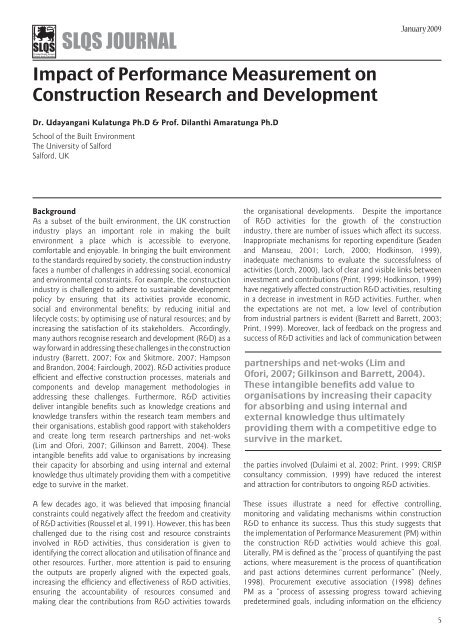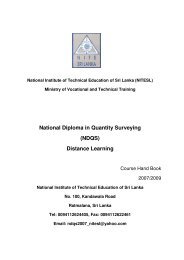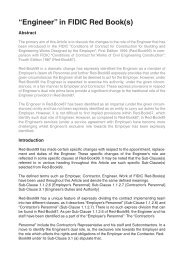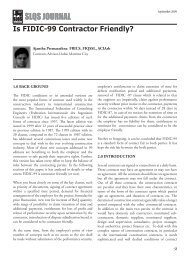SLQS-Journal Vol. 1 - Slqs-uae.org
SLQS-Journal Vol. 1 - Slqs-uae.org
SLQS-Journal Vol. 1 - Slqs-uae.org
Create successful ePaper yourself
Turn your PDF publications into a flip-book with our unique Google optimized e-Paper software.
<strong>SLQS</strong> JOURNALJanuary 2009Impact of Performance Measurement onConstruction Research and DevelopmentDr. Udayangani Kulatunga Ph.D & Prof. Dilanthi Amaratunga Ph.DSchool of the Built EnvironmentThe University of SalfordSalford, UKBackgroundAs a subset of the built environment, the UK constructionindustry plays an important role in making the builtenvironment a place which is accessible to everyone,comfortable and enjoyable. In bringing the built environmentto the standards required by society, the construction industryfaces a number of challenges in addressing social, economicaland environmental constraints. For example, the constructionindustry is challenged to adhere to sustainable developmentpolicy by ensuring that its activities provide economic,social and environmental benefits; by reducing initial andlifecycle costs; by optimising use of natural resources; and byincreasing the satisfaction of its stakeholders. Accordingly,many authors recognise research and development (R&D) as away forward in addressing these challenges in the constructionindustry (Barrett, 2007; Fox and Skitmore, 2007; Hampsonand Brandon, 2004; Fairclough, 2002). R&D activities produceefficient and effective construction processes, materials andcomponents and develop management methodologies inaddressing these challenges. Furthermore, R&D activitiesdeliver intangible benefits such as knowledge creations andknowledge transfers within the research team members andtheir <strong>org</strong>anisations, establish good rapport with stakeholdersand create long term research partnerships and net-woks(Lim and Ofori, 2007; Gilkinson and Barrett, 2004). Theseintangible benefits add value to <strong>org</strong>anisations by increasingtheir capacity for absorbing and using internal and externalknowledge thus ultimately providing them with a competitiveedge to survive in the market.A few decades ago, it was believed that imposing financialconstraints could negatively affect the freedom and creativityof R&D activities (Roussel et al, 1991). However, this has beenchallenged due to the rising cost and resource constraintsinvolved in R&D activities, thus consideration is given toidentifying the correct allocation and utilisation of finance andother resources. Further, more attention is paid to ensuringthe outputs are properly aligned with the expected goals,increasing the efficiency and effectiveness of R&D activities,ensuring the accountability of resources consumed andmaking clear the contributions from R&D activities towardsthe <strong>org</strong>anisational developments. Despite the importanceof R&D activities for the growth of the constructionindustry, there are number of issues which affect its success.Inappropriate mechanisms for reporting expenditure (Seadenand Manseau, 2001; Lorch, 2000; Hodkinson, 1999),inadequate mechanisms to evaluate the successfulness ofactivities (Lorch, 2000), lack of clear and visible links betweeninvestment and contributions (Print, 1999; Hodkinson, 1999)have negatively affected construction R&D activities, resultingin a decrease in investment in R&D activities. Further, whenthe expectations are not met, a low level of contributionfrom industrial partners is evident (Barrett and Barrett, 2003;Print, 1999). Moreover, lack of feedback on the progress andsuccess of R&D activities and lack of communication betweenpartnerships and net-woks (Lim andOfori, 2007; Gilkinson and Barrett, 2004).These intangible benefits add value to<strong>org</strong>anisations by increasing their capacityfor absorbing and using internal andexternal knowledge thus ultimatelyproviding them with a competitive edge tosurvive in the market.the parties involved (Dulaimi et al, 2002; Print, 1999; CRISPconsultancy commission, 1999) have reduced the interestand attraction for contributors to ongoing R&D activities.These issues illustrate a need for effective controlling,monitoring and validating mechanisms within constructionR&D to enhance its success. Thus this study suggests thatthe implementation of Performance Measurement (PM) withinthe construction R&D activities would achieve this goal.Literally, PM is defined as the “process of quantifying the pastactions, where measurement is the process of quantificationand past actions determines current performance” (Neely,1998). Procurement executive association (1998) definesPM as a “process of assessing progress toward achievingpredetermined goals, including information on the efficiency5





